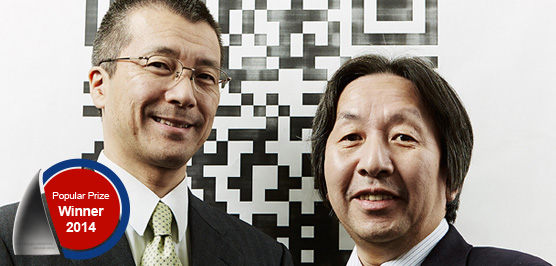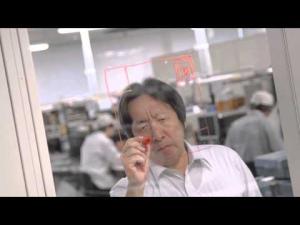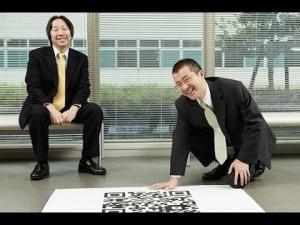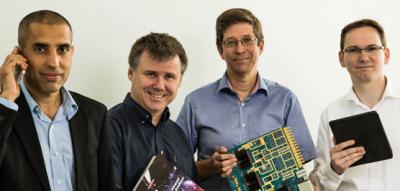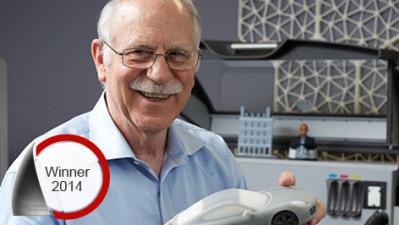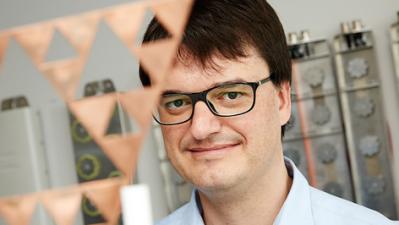Masahiro Hara, Motoaki Watabe, Tadao Nojiri, Takayuki Nagaya, Yuji Uchiyama
The QR code
Winners of the Popular Prize
QR codes, the ubiquitous black-and-white squares found everywhere from billboards to product packaging, have completely changed our concept of what bar codes can do. Uniquely suited to the digital age, the QR code pervades virtually every facet of contemporary consumer life, and it increasingly connects the physical world to the virtual worlds in our pockets.
Since a pack of Wrigley's Juicy Fruit gum was scanned at an Ohio supermarket in 1974, the familiar black-and-white stripes of the most popular bar code type - the one-dimensional UPC - have become an integral part of modern life.
With the intent to better track parts in car manufacturing, a team at automotive component manufacturer Denso Wave, then a division of Denso Corporation, led by Masahiro Hara decided to go even further: They developed a two-dimensional bar code. The result was the square "Quick Response Code", or QR code, released in 1994. It allows the scanner to find and interpret the code's information 20 times faster than previous matrix codes - and opens up countless new possibilities for meshing our physical and virtual lives.
Societal benefit
Using a smartphone as a scanner, consumers can connect directly to websites - and marketers are putting this ability to some creative uses: A QR code in a magazine ad can send readers to a website to buy a product; shoppers in a store are provided with more detailed information by QR codes on product labels; in South Korea, commuters can even shop by scanning QR codes from billboards depicting supermarket shelves.
Economic benefit
The number of European smartphone users scanning QR codes increased by 96% between 2011 and 2012 to 17.4 million users. A study by mobile computing company Nellymoser has shown that the use of QR and other mobile action codes in the Top 100 US magazines increased by 617% from January 2011 to December 2011, and QR code market share from 66% in January to 80% in December.
Meanwhile, Denso Wave has further developed QR technology with the iQR code to meet the industrial market's demand for a code with a higher data capacity, a reduced size, and a rectangular format.
How it works
A one-dimensional bar code conveys information by the width of its bars and spaces, or the difference in their horizontal dimension. In contrast, a two-dimensional matrix bar code like the QR code communicates information by the arrangement of dark and light elements in columns and rows. The position-detection patterns, located in three corners of each QR code, allow the code to be read quickly and from any angle.
Once a smartphone's camera processes the QR code's image, the scanning software begins to analyse it. The software calculates the ratio between the dark and light areas of the code and offsets any distortion, as well as obscured or missing areas. After digitally completing the QR code, the software examines the modules containing data, which it then transforms into readable information.
The inventor
The QR code had its start in Masahiro Hara’s attempt to improve his employer’s logistics system – and ended up a bridge between the physical and the virtual world. Hara’s invention has brought the Electrical Engineer and Managing Director at Denso Wave Incorporated the Excellence Award from Nikkei Business Publications in 2007 and the Good Design Award from the Japan Institute of Design Promotion in 2012.
Did you know?
The classic one-dimensional UPC can only hold about 20 alphanumeric characters, a limitation that became increasingly incompatible with the demands of industry and retail, especially after the advent of the information age. The QR code, used in any field of application from the retail industry to medicine, from transportation to advertisement, accepted this challenge and reads about 7 000 numerals, as well as alphabetic characters, symbols, Japanese, Chinese or Korean characters, and binary data.
Media gallery
Patent numbers:
Contact
European Inventor Award and Young Inventors Prize queries:
european-inventor@epo.org Subscribe to the European Inventor Award newsletterMedia-related queries:
Contact our Press team#InventorAward #YoungInventors
